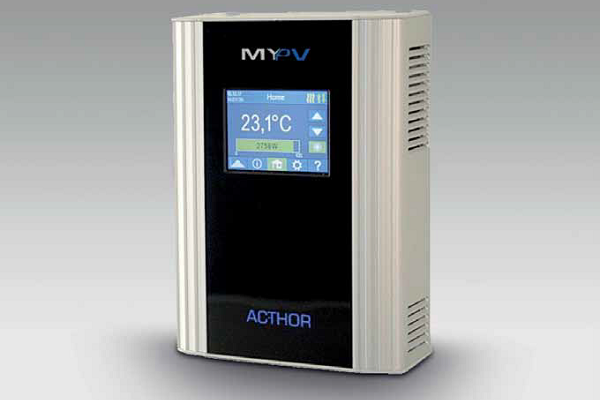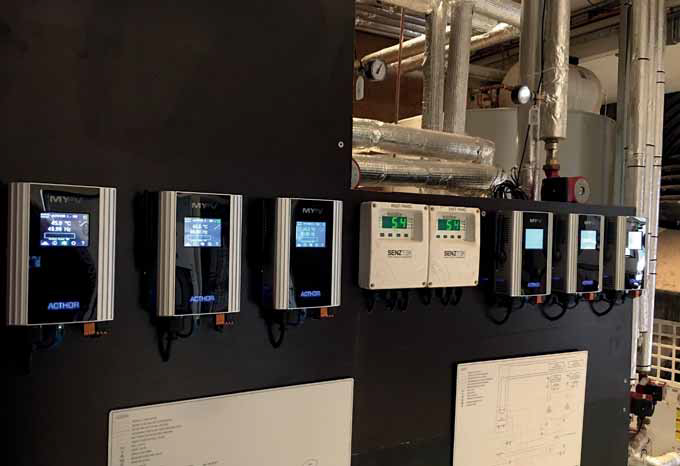The power of hot water
Jon Palfrey shares the latest innovation in hot water battery storage.
With a significant focus on energy availability, maximising self-consumption and use in all design and living parameters, it’s become necessary to not only make energy available in both on-grid and off – grid systems but to have that energy gathered, monitored and controlled to best use its availability and capacity to remain useful and productive.
One such method of energy capture and management is the AC•THOR power control module. The AC•THOR has the capacity to be the go between for solar PV energy yield via PV panels. The available captured energy produces heat in the form of hot water in storage tanks via linearly controlled power supplied to heating elements creating a thermal or ‘hot water storage battery’.
ADVERTISEMENT
AC•THOR9s is a 0 – 9 kW continuously variable photovoltaic power manager for hot water, electrical heat sources and optional space heating applications. It is small device in stature that can be located in a plant area for functional purposes that provides heated water control and thinks relative to demand requirements and available solar gains.
Stored water temperatures are controlled by a standard thermostat that links to the AC•THOR power management unit that supplements the available on grid power supply and off grid PV yield via connection to mains power supplies for when solar gain is limited due to unfavourable weather conditions.
Residential and commercial building designers are being influenced by developers and sustainability engineers who are seeking ways in which energy can be gathered, controlled, and used to
maximum benefit.
A device like the AC•THOR can meet this trend of energy control particularly when excess solar yield is available via PV solar panels from a device similar in size to a shoe box.
So how does AC•THOR work?
The electronic AC•THOR 9s Photovoltaic-Power-Manager (AC•THOR for short) is designed for operating resistive loads such as electric immersion heater elements, electric boilers, electric convectors, electric heating mats or infrared panels.
The unit controls the output voltage according to external signals (temperatures, Ethernet and other control signals) linearly and therefore the power output of the connected load.
The AC.THOR linear power control works similar to a grid connected inverter with high frequency switching power electronics.
This enables sinusoidal power consumption and avoids grid disturbances in contrast to other control technologies.
The AC•THOR is controlled by a my-PV Power Meter or can be combined with products such as inverters of different manufacturers including Fronius, SMA, Solaredge or Victron.
In operating mode, up to three electric heating elements can be supplied linearly with excess PV energy for water heating and other purposes.
The system’s temperature sensor is positioned in the storage tank above the heating element to provide an accurate temperature reading of gained energy.
In discussion with clients
The AC•THOR is a unique AC solar PV-Power-Controller for domestic hot water and space heating needs suitable for many residential and commercial applications. The AC•THOR 9s can
maximise end users PV self-utilisation by shifting excess solar PV energy linearly to power their electric heating requirements for both grid-connected and off-grid applications. Therefore, customers do not buy electricity unnecessarily from the grid when they have excess solar energy and achieve a net-zero energy goal.
Here are a few examples how AC•THOR 9s can assist to maximise consumer and industry self-consumption:
- For grid-connected systems, the AC•THOR 9s can communicate directly to compatible inverters, batteries or even energy management systems or through the my-PV Power Meter to measure your excess solar PV energy.
- For off-grid applications, with the help of a battery inverter, the AC•THOR 9s can detect a frequency shift in your AC line and power your hot water system linearly without additional
devices and wiring. - For residential applications, one AC•THOR 9s can be used to shift up to 9kW of excess solar energy to power your hot water tank, converting your hot water tank into a thermal storage
battery for your domestic hot water, hydronic heating and pool heating. - For commercial applications, 11 units of AC•THOR 9s can be linked up with only one my-PV Power Meter to manage up to 99 kW of your excess solar PV generation.
What can be recorded via the AC.THOR?
Recorded production data, meter values and temperatures can be read off at any time. The respective values can be selected using the data logger button on the module’s functional displays. These can be presented in the three views: current year, month or daily readings.
AC•THOR/AC•THOR 9S operating information
The following data can be displayed either from the screen or web interface:
Total power: Shows the total power figures for all the connected loads. The yellow bars indicate the PV excess power used, the green bars the proportion of grid energy when the optional temperature boost backup is active.
As examples:
- Meter: indicates the value of the total power drawn from the grid (red) including household loads and grid feed-in (green) at the metering point.
- Power 1,2 & 3 shows the power data for all three outputs.
- Temperature 1-4: shows the data via the temperature probe.
- Cloud connection devices available.
Case study – Agricultural study
An avocado farm in Western Australia produces 90 tons of avocados annually. The energy concept for the farm includes a 53kW photovoltaic system that simultaneously feeds a 160-kWh saltwater battery as well as a 48-kWh lithium energy storage. The farm is completely off-grid, operating on 100% renewable energy.
So why hybrid storage?
Photovoltaic off grid systems need to be oversized to provide enough energy during winter periods. This leads to unused PV power and a significant energy loss during sunny seasons.
The AC•THOR detects the grid frequency of the battery inverters and in case of excess energy, power is diverted to boost the hot water 9kW elements in each of the thermal tanks. The desired water temperature can also be easily adjusted with AC•THOR.
Storage capacity in the off-grid system can be inexpensively scaled up. Energy is now captured and used that was wasted before.
Project data
- 53kWp off -grid system, frequency shift inverters
- 160kWh saltwater battery and 48kWh lithium-cells
- Two tanks ROTEX Sanicube, each with a 9kW immersion heater powered by three AC•THORs
Operation with frequency shift
AC•THOR operates with frequency-shift battery inverters. These inverters raise the AC frequency when the battery is fully charged. This signals the PV inverter to limit power to prevent
battery overcharge.
AC•THOR detects excessive power by measuring this frequency rise. It increases heating power until the system is balanced, before the PV inverter derates. With that in mind it automatically uses the excess energy for hot water storage by controlling its power linearly to use exactly the amount of the remaining PV power and to avoid discharging the battery.
Installation
System schematic AC•THOR is plugged into an AC socket like any other load. No additional communication wiring is required.
- Product details AC•THOR
- Supply voltage 230-240 V
- 0 – 3,000 W linear power control
- Mains connection single-phase, mains plug
- Load connection mains socket for resistive loads
- Colour Touch Screen 2.83“
- Power cord 2.8 m for AC. THOR
- Dimensions 135 x 210 x 65 mm
- 3 phase 0 to 9kW version is available!
- Pure sine wave output with PWM regulation (pulse-width modulation). No thyristor required.
The operational order of the hybrid storage concept is to supply the present loads first, after which surpluses are used to charge the battery and the remaining excess energy is used for water heating.
The diagram shows:
- Sun and the PV inverter producing power
- AC•THOR and myPV Power Meter communicating
- Energy exporting to grid cancelled and redirecting the energy towards the ACTHOR (green arrow)
- Heating elements activated starting from the top
- Water being heated in the storage tank starting from the top.
In today’s markets and industry more and more people are looking for smarter ways to manage the use of solar PV energy to achieve net zero energy goal. This is especially challenging where the
cost of battery storage is still too high to store excess solar energy for a good return on investment economic return.
This method using the AC•THOR to convert storage tanks into true hot water batteries, can deliver the flexibility and cost-effective solution to maximise self-consumption in ever-increasing energy management strategies for both residential and commercial applications.
-
ADVERTISEMENT
-
ADVERTISEMENT




